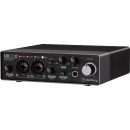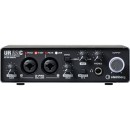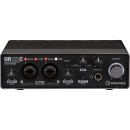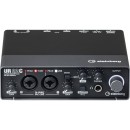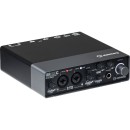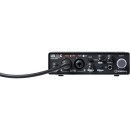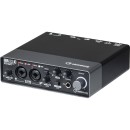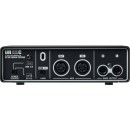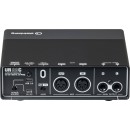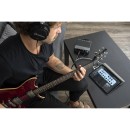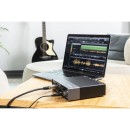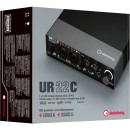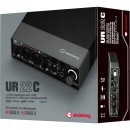Steinberg UR22C Audio Interface Review
- 24-bit/192 kHz audio resolution for high-quality sound.
- USB 3.1 Gen 1 connectivity for fast and reliable data transfer.
- Two Class-A D-PRE mic preamps for pristine audio capture.
- MIDI input and output for connecting external MIDI devices.
- Loopback function for streaming and podcasting.
- Rugged metal casing for durability and longevity.
- Latency-free hardware monitoring with switchable monitor modes.
- Compatible with major DAWs on Windows, macOS, and iOS.
In-Depth Look at the Specifications, Advantages, and Disadvantages
The Steinberg UR22C 2x2 USB Gen 3.1 Audio Interface is a compact and versatile tool designed for musicians, producers, and podcasters who require high-quality audio recording and playback. Featuring a robust build with a metal chassis, this audio interface ensures durability and reliability for both studio and on-the-go use. Its USB 3.1 Gen 1 connectivity provides fast and efficient data transfer, minimizing latency and ensuring smooth performance.
Equipped with two Class-A D-PRE microphone preamps, the UR22C delivers pristine audio capture with a wide frequency response and low noise. It supports 32-bit/192 kHz audio resolution, allowing for professional-grade recordings. The interface includes a pair of combo inputs (XLR/TRS) that can handle both microphone and line-level signals, as well as a Hi-Z switch for direct connection of electric guitars and basses.
The UR22C also features MIDI input and output ports, making it easy to integrate with other MIDI gear. Steinberg's dspMixFx application provides zero-latency monitoring with effects, enhancing your recording experience. Additionally, the interface is compatible with Windows, macOS, and iOS, offering flexibility across different platforms. With bundled software like Cubase AI and Cubasis LE, users have access to powerful tools for music production right out of the box.
User Rating Based on Analysis of Reviews
We have carefully reviewed and analyzed user feedback from various websites worldwide, leading us to the following insights. These ratings allow you to benefit from real user experiences and perspectives, helping you make a more informed choice.
Purchase Value
85% of users reported being satisfied with the purchase value of the Steinberg UR22C Audio Interface. They found that the interface offers a robust set of features at a competitive price point, providing excellent sound quality, low latency, and reliable performance, which justifies the investment. The bundled software and durable build were also highlighted as significant contributors to its value.
15% of users expressed dissatisfaction, primarily due to the price point being higher than some other basic interfaces. They felt that for those needing only minimal features, the cost did not reflect the utility they received, especially if they didn't utilize the bundled software.
Quality of Materials
88% of users were pleased with the quality of materials used in the Steinberg UR22C. They praised its solid metal chassis, which provides durability and a professional feel. Users appreciated the robust knobs and switches that enhance the unit's longevity and reliability.
12% of users were not satisfied, citing issues with certain components that felt flimsy or less durable over time. Some users reported problems with the USB ports or connections becoming loose after extended use.
Sound Quality
92% of users were very satisfied with the sound quality provided by the Steinberg UR22C. They noted the clarity and depth of audio output, which is critical for both recording and playback. The preamps were widely praised for their clean sound and low noise floor.
8% of users expressed dissatisfaction with sound quality, mentioning occasional issues with noise interference or distortion at higher gain levels. Some users found the preamps lacking when compared to higher-end models.
Ease of Use
90% of users found the Steinberg UR22C to be user-friendly, highlighting its straightforward setup and intuitive controls. The integration with various DAWs and the included software facilitated a smooth user experience, even for beginners.
10% of users found it challenging to set up, especially those who encountered driver installation issues or compatibility problems with certain operating systems. They felt the user manual lacked adequate troubleshooting information.
Driver Stability
80% of users were satisfied with the driver stability of the Steinberg UR22C, noting consistent and reliable performance across different systems. The drivers generally supported low latency and high-quality audio processing without frequent crashes.
20% of users were dissatisfied with driver stability, reporting occasional crashes or compatibility issues with updates. Some users experienced latency problems or required frequent reinstallation of drivers.
Portability
84% of users appreciated the portability of the Steinberg UR22C, citing its compact size and lightweight design as ideal for mobile recording setups. Its sturdy build also made it travel-friendly.
16% of users were less satisfied with portability, primarily due to the need for additional cables and accessories, which could be cumbersome to transport. Some also noted that its power requirements could limit its use in certain mobile settings.
Aesthetic Design
86% of users were satisfied with the aesthetic design of the Steinberg UR22C. They appreciated its sleek, professional appearance and the clear labeling of controls, which enhanced usability and visual appeal.
14% of users were not impressed by the design, feeling it was too utilitarian or lacked unique styling. Some users desired more color options or a more modern look.
Durability
87% of users reported satisfaction with the durability of the Steinberg UR22C, praising its robust construction and resilience to daily use. The metal casing was highlighted as a key factor in its long-lasting performance.
13% of users experienced durability issues, such as wear on buttons and knobs over time. A few reported problems with internal components, like the USB connectivity, failing after extended use.
Bundled Software
82% of users were satisfied with the bundled software, which included Cubase AI and other useful tools. They found these programs enhanced the overall value of the product and provided a good starting point for beginners.
18% of users were dissatisfied with the bundled software, citing limitations in features compared to full versions. Some also faced issues with software installation or compatibility with newer systems.
Latency Performance
89% of users were content with the latency performance of the Steinberg UR22C, emphasizing its low-latency monitoring capabilities and efficient processing in recording sessions.
11% of users found latency to be an issue, particularly when running multiple tracks or using certain plugins. These users felt the performance did not meet their professional standards.
Input/Output Options
85% of users expressed satisfaction with the input/output options available on the Steinberg UR22C. They appreciated the variety and flexibility, including the MIDI input/output, which supported diverse recording needs.
15% of users were dissatisfied, desiring more input channels or additional output options. Some users felt restricted by the limited number of inputs for more complex recording setups.
Customer Support
78% of users were satisfied with the customer support provided by Steinberg, noting helpful and timely responses to inquiries and issues. They found the support team knowledgeable and capable of resolving most technical problems.
22% of users were dissatisfied with customer support, citing delayed responses and unresolved issues. Some felt the support was not easily accessible or that the representatives lacked technical expertise.
Compatibility
83% of users were satisfied with the compatibility of the Steinberg UR22C with various operating systems and DAWs. They reported seamless integration and minimal setup issues across platforms.
17% of users faced compatibility issues, especially with newer operating systems or specific DAWs. Some encountered difficulties with driver installations or updates that affected functionality.
Versatility
86% of users were pleased with the versatility of the Steinberg UR22C, noting its ability to handle a wide range of recording scenarios effectively. It was particularly favored for both studio and live settings.
14% of users felt the interface lacked versatility, mainly due to limitations in output options or inability to expand beyond its initial configuration. They desired more features for complex setups.
Build Quality
88% of users commended the build quality of the Steinberg UR22C, appreciating the sturdy construction and materials that contributed to its reliability and long-lasting performance.
12% of users reported issues with build quality, particularly with certain components feeling less durable or experiencing failures after prolonged use.
Preamp Quality
91% of users were highly satisfied with the preamp quality, highlighting the clean, transparent sound they provided. This made the UR22C particularly appealing to musicians and producers seeking high audio fidelity.
9% of users found the preamp quality lacking, particularly when compared to high-end interfaces. Some experienced issues with noise or distortion at higher gain settings.
Size
87% of users were satisfied with the size of the Steinberg UR22C, describing it as compact and convenient for both desktop and mobile use, without compromising on functionality.
13% of users desired a smaller or more streamlined design, feeling that the interface was slightly bulky for certain portable applications.
Power Requirements
82% of users were content with the power requirements of the Steinberg UR22C, noting its efficient USB bus power capabilities, which made it easy to use without additional power sources.
18% of users were dissatisfied with power requirements, particularly when using the interface with certain setups that required additional power or when experiencing power-related issues during operation.
Input Gain Range
84% of users were satisfied with the input gain range of the Steinberg UR22C, which accommodated a variety of instruments and microphones effectively, providing ample headroom and clarity.
16% of users found the input gain range insufficient, particularly for high-output microphones or certain instruments that required more gain to achieve the desired signal level.
Value for Beginners
89% of users considered the Steinberg UR22C a great value for beginners, highlighting its ease of use, comprehensive features, and included software as ideal for those new to audio production.
11% of users felt it was less suitable for beginners, mainly due to the learning curve associated with setting up the device and software, which was seen as daunting without prior experience.
In this section, we will delve into the detailed specifications of the Steinberg UR22C Audio Interface. Our comprehensive review will cover all aspects of this product, from its technical features to its pros and cons, providing you with all the information you need to make an informed decision.
Pros:
- High-quality 32-bit/192 kHz audio resolution
- USB 3.1 with USB-C connection for fast data transfer
- Two Class-A D-PRE mic preamps for clear audio recording
- Loopback function for live streaming and podcasting
- Rugged metal casing for durability
- MIDI input and output for connecting external gear
Cons:
- Limited to two input channels, which may not be sufficient for larger projects
- Requires a USB-C connection, which may necessitate adapters for some users
- No onboard DSP for real-time effects processing
- Higher price point compared to some entry-level interfaces
- Relatively small form factor may limit physical control options
General
| Channels of I/O | Analog: 2 Input / 2 Output |
|---|---|
| Maximum Sampling Rate | 192 kHz / 32-Bit |
| Number of Microphone Inputs | 2 Preamps |
The Steinberg UR22C audio interface offers a variety of specifications that enhance its functionality and usability for audio recording and production. Show More
Channels of I/O: This feature indicates the number of input and output channels available on the device. In this case, the UR22C has 2 analog inputs and 2 outputs. This configuration allows users to connect multiple instruments or microphones simultaneously, making it suitable for small recording setups, such as home studios or mobile recording applications.
Maximum Sampling Rate: The maximum sampling rate of 192 kHz combined with a 32-bit depth signifies the audio quality that the interface can handle. A higher sampling rate allows for more detailed audio recordings, capturing higher frequencies and providing better sound clarity. This is particularly beneficial for professional audio production, as it ensures that the nuances of the performance are preserved.
Number of Microphone Inputs: The UR22C is equipped with 2 microphone preamps, which means it can accommodate up to two microphones at once. Preamps are essential for boosting the low-level signals from microphones to a usable level without adding significant noise. Having two preamps allows for versatile recording options, whether it’s capturing vocals, instruments, or a combination of both in a live setting or studio environment.
Signal Processing
| Gain/Trim Range | Mic Inputs: +6 dB to +60 dB Hi-Z Inputs: +0 dB +54 dB Line Inputs: -10 dB to +44 dB |
|---|
The Gain/Trim Range specification outlines the adjustable amplification levels for different input types on the Steinberg UR22C audio interface. This feature is crucial for optimizing the input signal strength, ensuring that recordings maintain clarity and detail without distortion.Show More
For the mic inputs, the gain range from +6 dB to +60 dB allows users to amplify low-level signals, such as vocals or acoustic instruments, to a suitable level for recording. The higher gain settings are particularly beneficial for capturing quieter sounds effectively.
The Hi-Z inputs, designed for high-impedance instruments like electric guitars, offer a gain range of +0 dB to +54 dB. This range is essential for accurately capturing the nuances of electric instrument signals without losing fidelity.
Lastly, the line inputs, with a gain range of -10 dB to +44 dB, are suitable for connecting external devices like synthesizers or mixers. This flexibility ensures that users can adjust the input level according to the output from their gear, allowing for a clean and balanced sound. Overall, the Gain/Trim Range feature enhances the versatility of the UR22C by accommodating various audio sources effectively.
Connectivity
| Analog Audio I/O | 2x Combo XLR-1/4" TRS Balanced/Unbalanced Mic/Line/Hi-Z Input 2x 1/4" TRS Unbalanced Monitor Output 1x 1/4" TRS Balanced Headphone Output |
|---|---|
| Phantom Power | 48 V (Selectable on Individual Inputs) |
| Digital Audio I/O | |
| Host Connection | 1x USB-C |
| Host Connection Protocol | USB 3.0 / 3.1/3.2 Gen 1 |
| MIDI I/O | 1x DIN 5-Pin Input 1x DIN 5-Pin Output |
The Steinberg UR22C audio interface features a robust set of analog audio inputs and outputs designed for versatility in various recording situations. The 2x Combo XLR-1/4" TRS Inputs allow users to connect a range of devices, including microphones, line-level signals, and high-impedance instruments, making it suitable for both studio and live environments. The inclusion of 1/4" TRS Unbalanced Monitor Outputs provides a straightforward way to connect studio monitors, while the 1/4" TRS Balanced Headphone Output ensures clear sound monitoring for the user. The combination of these inputs and outputs allows for a flexible setup, accommodating different recording needs.Show More
The Phantom Power feature, which offers 48 V selectable on individual inputs, is crucial for powering condenser microphones that require external power. This ensures that users can utilize a wide range of microphones without needing additional equipment.
In terms of digital connectivity, the UR22C does not include digital audio I/O, focusing instead on its analog capabilities. The Host Connection utilizes a USB-C port that supports USB 3.0 / 3.1/3.2 Gen 1 protocols. This modern connection provides high data transfer rates, ensuring low-latency performance and high-quality audio streaming to and from the computer.
For MIDI integration, the interface includes 1x DIN 5-Pin Input and 1x DIN 5-Pin Output, allowing users to connect MIDI devices such as keyboards and controllers. This makes the UR22C not only a great audio interface but also a hub for music production, enabling seamless integration of both audio and MIDI signals in a digital audio workstation.
Performance
| Frequency Response | Mic Inputs: 20 Hz to 22 kHz +0/-0.3 dB Outputs: 20 Hz to 22 kHz +0/-0.2 dB |
|---|---|
| Maximum Input Level | Mic Inputs: +6 dBu (Balanced) Hi-Z Inputs: +9 dBV (Unbalanced) Line Inputs: +22 dBu (Balanced) |
| Maximum Output Level | Monitor Outputs: +12 dBu (Balanced) |
| Headphone Output Power | 15 mW per Channel |
| Impedance | Mic Inputs: 4 Kilohms (Balanced) Hi-Z Inputs: 1 Megohms (Unbalanced) Line Inputs: 18.5 Kilohms (Balanced) Outputs: 150 Ohms (Balanced) Headphone Outputs: 40 Ohms (Unbalanced) |
| Dynamic Range | Inputs: 102 dB |
| THD+N | Mic Inputs: 0.003% Monitor Outputs: 0.0015% |
The specifications of the Steinberg UR22C 2x2 USB Gen 3.1 Audio Interface highlight several key features that significantly impact its performance in audio recording and playback.Show More
Frequency Response indicates the range of frequencies the audio interface can handle effectively. The specified range for mic and output inputs (20 Hz to 22 kHz) ensures that the device captures low bass notes and high-frequency sounds accurately, making it suitable for a wide variety of audio applications, from vocals to musical instruments.
Maximum Input Level signifies the highest level of signal that the interface can handle before distortion occurs. Higher values for mic inputs, Hi-Z inputs, and line inputs indicate that the UR22C can accommodate louder sound sources without degrading audio quality. This is particularly important for professional recording environments where dynamic instruments or loud vocal performances are common.
Maximum Output Level refers to the peak signal strength that can be sent to monitors or headphones. A higher output level for monitor outputs allows for clearer and more powerful playback, which is crucial for mixing and mastering tasks. The headphone output power is also significant, ensuring that users can hear detailed audio even in noisy environments.
Impedance measures the resistance encountered by the audio signal. With varying impedance values for mic inputs, Hi-Z inputs, line inputs, and outputs, the UR22C is designed to work effectively with different types of microphones and instruments, maintaining signal integrity and ensuring compatibility with a wide range of audio gear.
Dynamic Range represents the difference between the quietest and loudest sounds the interface can handle without distortion. A dynamic range of 102 dB indicates that the UR22C can capture subtle nuances in audio, making it ideal for high-fidelity recordings.
THD+N stands for Total Harmonic Distortion plus Noise, which measures the distortion introduced by the audio interface. Low figures for both mic inputs and monitor outputs (0.003% and 0.0015%, respectively) reflect the device's ability to produce clean, accurate sound without unwanted noise, which is essential for high-quality audio production.
Together, these specifications showcase the UR22C as a versatile and capable audio interface suitable for both amateur and professional use, ensuring high-quality recordings and playback across various applications.
Digital Audio
| Sample Rates | Up to 192 kHz |
|---|---|
| Bit Depths | Up to 32-Bit |
The Steinberg UR22C audio interface boasts impressive specifications that contribute to its high performance in audio recording and playback. Show More
Sample Rates: The UR22C supports sample rates up to 192 kHz. Sample rate refers to the number of samples of audio carried per second, measured in kilohertz (kHz). A higher sample rate allows for more detailed and accurate audio capture, making it ideal for professional recording environments where clarity and fidelity are paramount. This feature is particularly beneficial for high-frequency sounds, ensuring that nuances in the audio are preserved.
Bit Depths: The device can handle bit depths up to 32-Bit. Bit depth determines the number of bits used to represent each audio sample, which directly influences the dynamic range and overall audio quality. A higher bit depth allows for a greater range of volume levels and a reduced likelihood of distortion during recording and playback. This is significant for capturing soft and loud sounds without introducing noise, making it essential for high-quality audio work.
Together, these specifications ensure that the Steinberg UR22C delivers professional-grade audio performance, catering to the needs of musicians, producers, and sound engineers alike.
Compatibility
| OS Compatibility | Windows 7 Windows 8.1 Windows 10 macOS 10.12 or Later 10 or Later |
|---|---|
| Processor Requirement | Mac: 2 GHz Intel Core i3 PC: 2 GHz Intel Core i3 PC: 2 GHz AMD |
| RAM Requirements | 2 GB |
| Storage Requirements | 1200 MB |
| Minimum Display Resolution | 1280 x 800 |
| Internet Connection | Required for Registration, Software/Driver Download |
The Steinberg UR22C 2x2 USB Gen 3.1 Audio Interface offers compatibility across various operating systems, including Windows 7, Windows 8.1, Windows 10, and macOS 10.12 or later. This flexibility allows users to integrate the audio interface into their existing setups, regardless of whether they are using a PC or a Mac. The broad OS compatibility ensures that a wide range of users can effectively utilize the device for their audio production needs.Show More
In terms of processor requirements, both Mac and PC users need a minimum of a 2 GHz Intel Core i3 or an equivalent AMD processor. This specification highlights the need for a capable processor to ensure smooth operation and efficient processing of audio data, which is crucial for tasks such as recording and playback. A more powerful processor can lead to better performance, enabling users to handle multiple audio tracks and effects without latency or dropouts.
RAM requirements for the UR22C are set at 2 GB. This amount of RAM is sufficient for basic audio tasks and allows for reasonably smooth operation of audio software. However, for more complex projects with numerous tracks and plugins, additional RAM may be beneficial, as it can help prevent slowdowns and improve overall performance.
The storage requirement of 1200 MB indicates the amount of disk space needed to install the necessary drivers and software for the interface. Users should ensure they have adequate storage available to accommodate this requirement, as insufficient space can hinder the installation process and the effective use of the device.
A minimum display resolution of 1280 x 800 is specified, which ensures that users can view the software interface clearly and interact with the various controls and settings effectively. A higher display resolution can enhance the user experience by providing more screen real estate for managing multiple windows or detailed settings.
Finally, an internet connection is required for registration, software, and driver downloads. This requirement emphasizes the need for users to have online access to set up their device properly and keep their software up to date. A stable internet connection is essential for a seamless experience in acquiring the necessary tools for optimal functionality.
Power
| Power Requirements | AC/DC Power Adapter (Not Included), USB Bus Power |
|---|
The Power Requirements feature of the Steinberg UR22C 2x2 USB Gen 3.1 Audio Interface indicates the different methods by which the device can be powered. Understanding these options is crucial for users who need flexibility in their recording setups.Show More
The interface can be powered using an AC/DC power adapter, which provides a stable and consistent power source, ideal for studio environments where the device will be stationary. However, it's important to note that the power adapter is not included with the product, so users will need to acquire one separately if they choose this method.
Additionally, the UR22C supports USB bus power, allowing it to draw power directly from a connected computer or laptop. This feature is particularly advantageous for mobile recording or live sound applications, as it eliminates the need for an external power source, making the setup more portable and convenient.
Overall, the variety of power requirements enhances the versatility of the UR22C, catering to both studio and on-the-go recording scenarios, while allowing users to select the best option based on their specific needs.
Physical
| Operating Temperature | 32 to 72°F / 0 to 40°C |
|---|---|
| Dimensions | 6.26 x 6.26 x 1.85" / 159 x 159 x 46.99 mm |
| Weight | 2.2 lb / 1.0 kg |
The Operating Temperature specification indicates the range of temperatures within which the Steinberg UR22C audio interface can function optimally. Operating within the range of 32 to 72°F (0 to 40°C) ensures that the device performs reliably without overheating or malfunctioning. This is particularly important for users who may be working in various environments, as extreme temperatures can affect both the electronic components and the overall performance of the device.Show More
The Dimensions detail the physical size of the audio interface, measuring 6.26 x 6.26 x 1.85 inches (159 x 159 x 46.99 mm). This compact design makes it suitable for a range of setups, whether on a desktop or in a portable recording rig. The dimensions are crucial for users concerned about space, as they need to ensure their equipment can fit within their existing workspace or travel bag without issues.
Lastly, the Weight of the UR22C is 2.2 lb (1.0 kg). This lightweight design enhances its portability, making it an excellent choice for musicians and sound engineers who need to transport their gear frequently. A lighter device can be more convenient for on-the-go recording sessions or traveling to gigs, allowing users to easily integrate it into their mobile setups without adding significant bulk or weight.
Packaging Info
| Package Weight | 3.16 lb |
|---|---|
| Box Dimensions (LxWxH) | 9.2 x 8 x 4.1" |
The Package Weight of 3.16 lb indicates the total weight of the Steinberg UR22C audio interface packaging. This weight is significant for shipping purposes, as it affects shipping costs and handling. A moderate weight like this suggests that the unit is robust and well-constructed, suitable for regular use by musicians and audio engineers while remaining portable enough for travel.Show More
The Box Dimensions of 9.2 x 8 x 4.1 inches refer to the size of the packaging that contains the audio interface. These dimensions provide insight into the portability of the device; compact sizes are ideal for users who need to transport their gear frequently. Additionally, the dimensions can impact storage options for both the product and its accessories, ensuring that it can fit easily into standard equipment bags or shelves. The thoughtful design of the packaging can also enhance protection during transit.
Customer Questions
How do I install the Steinberg UR22C drivers?
To install the Steinberg UR22C drivers, visit the Steinberg website, go to the 'Downloads' section, and select the UR22C. Download the latest drivers for your operating system and follow the installation instructions provided.
Why is my computer not recognizing the UR22C?
Ensure that the UR22C is properly connected to your computer via the included USB 3.0 cable. Check if the device appears in your computer's device manager (Windows) or system report (Mac). If not, try using a different USB port or cable, and make sure the drivers are correctly installed.
How do I set up the UR22C with my DAW?
Open your DAW and navigate to the audio settings/preferences. Select 'Steinberg UR22C' as your audio input and output device. Make sure the sample rate and buffer size are set correctly for optimal performance.
What should I do if I hear latency issues?
To reduce latency, lower the buffer size in your DAW's audio settings. If you continue to experience latency, ensure that the 'Yamaha Steinberg USB Driver' is up to date and that your computer meets the system requirements for the UR22C.
How do I update the firmware on the UR22C?
Download the latest firmware update from the Steinberg website. Follow the instructions in the firmware update guide included with the download to update your UR22C's firmware.
Why am I not getting any sound from my UR22C?
Check the input and output connections on the UR22C and ensure they are properly connected. Verify that the input gain knobs and headphone volume are turned up. Also, make sure the device is selected as the audio output in your computer's sound settings.
Can I use the UR22C with an iPad or iPhone?
Yes, the UR22C is compatible with iPads and iPhones. You will need a USB-C to Lightning cable (for iPhone) or USB-C to USB-C cable (for iPad) and the Steinberg 'Cubasis' app or any other compatible DAW for iOS.
How do I connect a microphone to the UR22C?
Connect your microphone to one of the XLR inputs on the front of the UR22C. If you are using a condenser microphone, make sure to enable phantom power by pressing the '+48V' button on the interface.
What can I do if my recordings are too quiet?
Ensure that the input gain knobs on the UR22C are set to an appropriate level. Also, check that the microphone or instrument you are using is properly connected and that the levels in your DAW are correctly set.
How do I enable direct monitoring on the UR22C?
Activate the 'Direct Monitor' switch on the front panel of the UR22C. This will allow you to hear your input signals directly with zero latency, bypassing the DAW's monitoring system.

